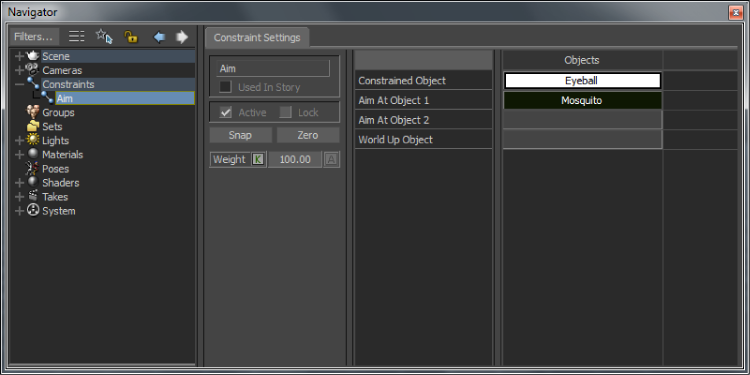Use the Aim constraint to make an object point in the direction of another object, creating an effect similar to a camera interest.

The Aim constraint
The Aim constraint requires the following objects:
An asset, model, or other object whose orientation derives from the Aim At Object(s) position. Also known as the “child” object.
Object from which the position of the constrained object is derived. You can have multiple Aim At objects for this constraint.
Lets you select an asset, model, or other object whose orientation defines the Up rotation for the object.
The following Aim constraint settings are found only in the Properties window when the constraint is selected in the Scene browser:
| Properties window setting | Function |
|---|---|
| Aim Vector | Lets you set a specific XYZ axis for the constrained object to orient towards. Expand Aim Vector to view the individual X, Y, and Z axes. |
| Up Vector | Lets you set a specific XYZ axis for the object whose orientation defines the Up rotation for the object. Expand Up Vector to view the individual X, Y, and Z axes. |
| Rotation Offset | Lets you set a specific XYZ offset for the object whose orientation defines the Up rotation for the object. Expand Rotation Offset to view the individual X, Y, and Z axes. |
| World Up Type | An asset, model, or other object whose orientation defines the Up for the object. See World Up type settings for information about what objects you can specify as a World Up Type. |
| Up Vector | Lets you specify an X, Y, or Z coordinate for the Up Vector. |
| World Up Object | Lets you assign an asset. model, or other object whose orientation defines the Up for the constrained object. This is the same setting as the World Up Object cell in the Navigator window Aim constraint settings. This setting is active when either Object Up or Object Rotation Up is selected at the World Up Type. |
| Constraint Axes | Activate the Affect X, Y, or Z axis option to assign which axis the Aim constraint takes effect on. |
| [Object] Weight | Adjust the Weight setting(s) to set the amount of influence the Source object has over the constrained objects, letting you create constraint “blends”. Each Aim At object has a Weight slider so you can modify its offset. |
 Except where otherwise noted, this work is licensed under a Creative Commons Attribution-NonCommercial-ShareAlike 3.0 Unported License
Except where otherwise noted, this work is licensed under a Creative Commons Attribution-NonCommercial-ShareAlike 3.0 Unported License